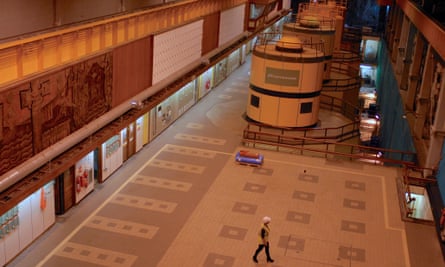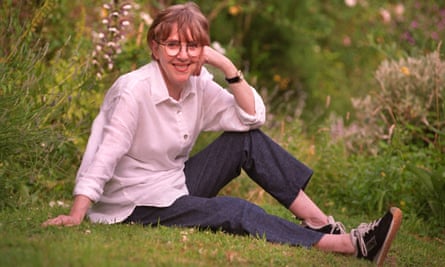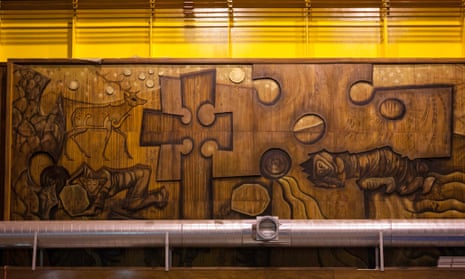If you want to get up close to the most remote work of art in Britain, you’ll need to make a 2 ½-hour train journey from Glasgow to the Highlands, drive 1km into the heart of a mountain and climb a flight of slippery steps on to a viewing platform before you can catch a glimpse: a 48ft x 12ft mural made of wood, plastic and gold leaf, sparkling away at the centre of a vast cave like some fairytale treasure. In terms of accessibility, it’s not the fourth plinth in Trafalgar Square: even the artist behind the work has never made the trek to see it in situ.
What may sound like some postmodern joke on modern art’s elitism is, in fact, the opposite: a period piece that tells a story of a very different Britain, a country in which artists enjoyed a more intimate relationship with the world of industry than that of entertainment. For years, the work and its creator, Elizabeth Falconer, were forgotten. A new radio play by the art writer Maria Fusco, co-commissioned by Radio 4 and Artangel, now rediscovers its significance.
Fifty years ago, Ben Cruachan in Argyll and Bute was the equivalent of London’s Silicon roundabout – a place of technological innovation on which an entire nation was pinning its hopes for the future. The madcap idea was to turn a rugged peak in the Scottish highlands into a geological battery: using excess energy in the national grid, water would be pumped from Loch Awe at the bottom of the mountain into a reservoir at the top. Whenever the grid experienced a surge in demand – when the nation switched on its kettle during the Coronation Street ad break, say – you could simply release water back down the mountain through the turbines and reproduce energy at a few seconds’ notice.

Much like the wind farms that dot the highlands today, hydroenergy inspired and antagonised in equal measure. Tom Johnston, the socialist secretary of state for Scotland, found himself facing an unholy alliance of landowners and union leaders concerned about job losses in the coal industry. “Great landlords and sporting gentrice who lived in London or the Riviera most of the year … joined glad hands with a half-baked Celticism which objected to selling any water power to the southern countries of Scotland,” he later recalled.
But Cruachan is a reminder that Harold Wilson’s “white heat of technology” was once more than just a cliche. While the US and the Soviet Union were racing into space, Scotland was drilling with similar pioneering fervour in the other direction.
Three thousand construction workers were hired to blast a tunnel to the heart of the mountain. Working in dynamite and granite, explosives experts known as “tunnel tigers” went down the shaft wearing tight-fitting teddy boy suits they had bought with danger money – and casually snapped up a new tunnelling world record in their effort to finish the project in time. Thirty-six of them would be dead by the time the Queen opened the first reversible hydroelectric power station in Scotland on 15 October 1965.
But royal attendance wasn’t enough to do justice to this engineering miracle. The architects decided to commission a mural to tell the project’s story: a Scottish followup to Diego Rivera’s Detroit Industry murals of the 1930s, or a more static precursor to the Google doodle. As Fusco’s radio play puts it: “The mountain’s story is vertical in the making, yet horizontal in the telling.”
Stylistically, the installation is in keeping with what architecture critics at the time described as “sane modernism”: Celtic crosses mingle with pylons, mythical beasts with men of industry. The first section depicts the Cailleach Bheur, an old hag who, according to Gaelic folklore, used to guard the spring underneath the mountain. The middle panel pays tribute to 15 workers who died when the roof of the turbine hall collapsed; the final section shows the station chugging away in all its glory.

With its mix of nationalist iconography, socialist zeal and celebration of renewable energy, it looks like the kind of artwork that would sit comfortably in the SNP head offices today – were it not for the fact that its creator is not a local mural veteran like Robert Stewart or Alasdair Gray, but a politely spoken Englishwoman living in the genteel Gloucestershire countryside.
Elizabeth Falconer, now 87, was approached with the commission via her husband, an architect partner of one of the engineers working on the Cruachan power station and a native of Aberdeen. But the mural was created entirely in London, in her tiny workman’s cottage on the Hogarth roundabout in Chiswick. “They just told me they had a space to fill,” she says, sitting at her writing desk in a converted barn, “so I set about seeing what I could do.”
Soon after the mural’s panels had made their way up north in a furniture van, contact was severed – the plaque at the visitors centre still misspells the artist’s name as “Faulkner” – until three years ago, when her son visited the power station. While most of the workers inside the power station are too familiar with the mural to give it much attention, he found that Cruachan now draws scores of tourists who gaze at his mother’s work as if it were a fresco inside the Sistine Chapel. “They called me up the other day,” she says. “Apparently I’m quite a big star in the Highlands these days.”
Master Rock is on Radio 4 on 17 October at 10.15pm.
- This article was amended on 2 November 2015. It originally referred to
Diego Rivera’s murals “for the Ford Motor Company in 1930s Detroit”. To clarify, the murals were for the Detroit Institute of Arts and paid for by Edsel Ford in his capacity as an art patron, not as a Ford executive. While they depict Ford workers, they also include depictions of other industries in 1930s Detroit. This has been corrected.

Comments (…)
Sign in or create your Guardian account to join the discussion